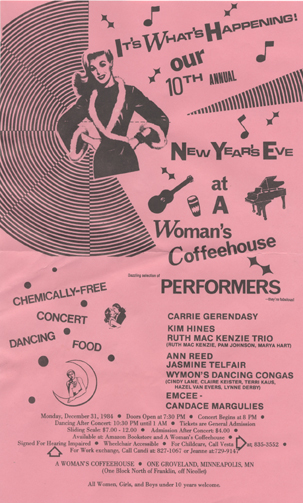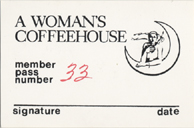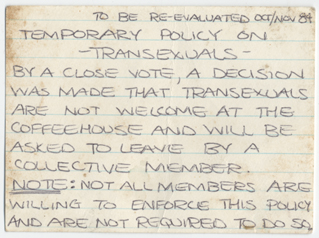Difference between revisions of "A Woman's Coffeehouse"
| (12 intermediate revisions by 3 users not shown) | |||
| Line 4: | Line 4: | ||
| − | Begun in 1975 at the [[Lesbian Resource Center]],<small>(1)</small> the collectively-owned venue was an apparent first—it offered a chemically free late-night venue for queer women that did not enjoy the bar scene at [[Ladies Night]], [[Foxy's Bar]], or [[The Town House Bar]]. | + | {{unprotected}} |
| + | {| {{prettytable}} | ||
| + | ! | ||
| + | ! | ||
| + | |- | ||
| + | | | ||
| + | <div style="text-align: center;"> | ||
| + | [[Image:Svc_awcposter.jpg]] | ||
| + | </div> <div style="text-align: center;"> | ||
| + | <small>'''The Coffeehouse hosted an immensely popular New Years Eve celebration. Image Courtesy of the [[Jean-Nickolaus Tretter Collection]].'''</small> | ||
| + | </div> | ||
| + | | Begun in 1975 at the [[Lesbian Resource Center]],<small>(1)</small> the collectively-owned venue was an apparent first—it offered a chemically free late-night venue for queer women that did not enjoy the bar scene at [[Ladies Night]], [[Foxy's Bar]], or [[The Town House Bar]]. | ||
| − | Toni McNaron, a respected University of Minnesota professor, was among the queer-indentified feminists who comprised a majority at A Woman’s Coffeehouse. After moving to basement space at the Plymouth Congregational Church, the Coffehouse women gathered in semi-privacy. | + | Toni McNaron, a respected University of Minnesota professor, was among the queer-indentified feminists who comprised a majority at A Woman’s Coffeehouse. After moving to basement space at the Plymouth Congregational Church, the Coffehouse women gathered in semi-privacy. |
| − | + | At the time, many women were frightened of entering “known” lesbian spaces; the FBI kept tabs on women’s gatherings at the time. Many women were simply afraid of losing their occupations, including respected University of Minnesota professor Toni McNaron and future State Representative Karen Clark.<small>(2)</small> | |
| − | The coffeehouse predated the 1980s lesbian bar scene in St. Paul, and eventually the business model proved ineffective. Women who abstained from alcohol grew tired of the venue, and began going to lesbian-friendly bars to dance with other women. Membership dwindled, and the organization closed in | + | Typically open on the weekends, the coffeehouse was a performance space and a venue for lively (if sometimes heated) discussions about lesbian issues. These gatherings were largely constructive; the coffeehouse reached out to women of color after some patrons accused the establishment of exclusively catering to white women. |
| + | |} | ||
| + | |||
| + | |||
| + | <div style="text-align: center;"> | ||
| + | [[Image:Svc_awccard.jpg]] | ||
| + | |||
| + | <small>'''Membership card, courtesy of the [[Jean-Nickolaus Tretter Collection]]'''</small> | ||
| + | </div> | ||
| + | |||
| + | |||
| + | In a 1985 flyer, the collective announced “some of our main goals are to bridge the cultural gaps between white women and women of color and break down the walls of alienation that have been built up over the years.”<small>(3)</small> That same year, approximately half of the patrons were people of color, and the same balance existed on stage. | ||
| + | |||
| + | |||
| + | {| {{prettytable}} | ||
| + | ! | ||
| + | ! | ||
| + | |- | ||
| + | | | ||
| + | The coffeehouse predated the 1980s lesbian bar scene in St. Paul, and eventually the business model proved ineffective. Women who abstained from alcohol grew tired of the venue, and began going to lesbian-friendly bars to dance with other women. Membership dwindled, and the organization closed in September of 1989.<small>(5)</small> | ||
University of Wisonsin-Madison professor Anne Enke wrote extensively of A Woman’s Coffehouse in her book: ''Finding the Movement: Sexuality, Contested Space, and Feminist Activism''. Information for this page is the result of her extensive study. | University of Wisonsin-Madison professor Anne Enke wrote extensively of A Woman’s Coffehouse in her book: ''Finding the Movement: Sexuality, Contested Space, and Feminist Activism''. Information for this page is the result of her extensive study. | ||
| + | | <div style="text-align: center;"> | ||
| + | [[Image:Svc_awctrans.jpg]] | ||
| + | </div> <div style="text-align: center;"> | ||
| + | <small>'''The Coffeehouse was a site of constant scandal--this card is the product of a controversial decision to ban transgender people from participating. Courtesy of the [[Jean-Nickolaus Tretter Collection]].'''</small> | ||
| + | </div> | ||
| + | |} | ||
| + | |||
| + | |||
| + | <div style="text-align: left; direction: ltr; margin-left: 1em;"> | ||
---- | ---- | ||
| + | ==This entry is part of:== | ||
| + | == [[Minneapolis/St. Paul, MN: 100 Queer Places in Minnesota History, (1860-2010)]]== | ||
| + | ---- | ||
| + | |||
| + | |||
<small>(1)</small>Enke, Anne. ''Finding the Movement: Sexuality, Contested Space, and Feminist Activism''. North Carolina: Duke University Press, 2007. Page 224. | <small>(1)</small>Enke, Anne. ''Finding the Movement: Sexuality, Contested Space, and Feminist Activism''. North Carolina: Duke University Press, 2007. Page 224. | ||
| Line 27: | Line 71: | ||
<small>(3)</small>Anderson, Shelley. “Coffeehouse Makes Changes.” ''Equal Time'', 12/18/1985. Page 9. | <small>(3)</small>Anderson, Shelley. “Coffeehouse Makes Changes.” ''Equal Time'', 12/18/1985. Page 9. | ||
| − | <small>(4)</small> | + | <small>(4)</small> Dryer, Peg and Porte, Trina. "The Coffeehouse: A Final Accounting." ''[[Equal Time]]'' News, 8/3-8/17/90. Page 4. |
| − | |||
| − | |||
| − | |||
| − | |||
Latest revision as of 02:10, 20 January 2012
1900 Nicollet Avenue, Minneapolis, MN. (1975-1988)
|
The Coffeehouse hosted an immensely popular New Years Eve celebration. Image Courtesy of the Jean-Nickolaus Tretter Collection. |
Begun in 1975 at the Lesbian Resource Center,(1) the collectively-owned venue was an apparent first—it offered a chemically free late-night venue for queer women that did not enjoy the bar scene at Ladies Night, Foxy's Bar, or The Town House Bar.
|
Membership card, courtesy of the Jean-Nickolaus Tretter Collection
In a 1985 flyer, the collective announced “some of our main goals are to bridge the cultural gaps between white women and women of color and break down the walls of alienation that have been built up over the years.”(3) That same year, approximately half of the patrons were people of color, and the same balance existed on stage.
|
The coffeehouse predated the 1980s lesbian bar scene in St. Paul, and eventually the business model proved ineffective. Women who abstained from alcohol grew tired of the venue, and began going to lesbian-friendly bars to dance with other women. Membership dwindled, and the organization closed in September of 1989.(5)
|
The Coffeehouse was a site of constant scandal--this card is the product of a controversial decision to ban transgender people from participating. Courtesy of the Jean-Nickolaus Tretter Collection. |
This entry is part of:
Minneapolis/St. Paul, MN: 100 Queer Places in Minnesota History, (1860-2010)
(1)Enke, Anne. Finding the Movement: Sexuality, Contested Space, and Feminist Activism. North Carolina: Duke University Press, 2007. Page 224.
(2)Enke, page 225.
(3)Anderson, Shelley. “Coffeehouse Makes Changes.” Equal Time, 12/18/1985. Page 9.
(4) Dryer, Peg and Porte, Trina. "The Coffeehouse: A Final Accounting." Equal Time News, 8/3-8/17/90. Page 4.


